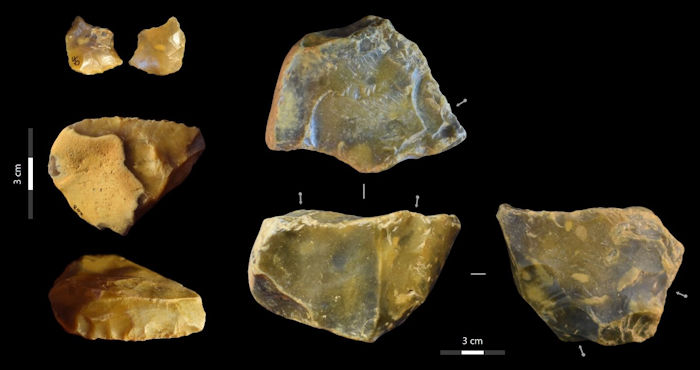600,000-Year-Old Finds Reveal Canterbury Was Home To Britain’s Earliest Humans
Jan Bartek – MessageToEagle.com – Archaeological discoveries made on the outskirts of Canterbury, Kent (England) confirm the presence of early humans in southern Britain between 560,000 and 620,000 years ago, making it one of the earliest known Paleolithic sites in northern Europe.
The breakthrough, involving controlled excavations and radiometric dating, comes a century after stone tool artifacts were first uncovered at the site.
A fossil skull cast of Homo heidelbergensis (not found at the site). Credit: Giuseppe Castelli, Department of Archaeology, University of Cambridge
The research, led by archaeologists at the University of Cambridge, confirms that Homo heidelbergensis, an ancestor of Neanderthals, occupied southern Britain in this period (when it was still attached to Europe) and gives tantalizing evidence hinting at some of the earliest animal hide processing in European prehistory.
Located in an ancient riverbed, the Canterbury site was originally discovered in the 1920s when local laborers unearthed artifacts known as handaxes (most now in the British Museum), but by applying modern dating techniques to new excavations their age has finally been determined.
Led by Cambridge’s Department of Archaeology, the recent excavations have not only dated the original site but also identified new flint artifacts, including the very first “scrapers” to be discovered there.
The researchers have dated these stone tool artifacts using infrared-radiofluorescence (IR-RF) dating, a technique which determines the point at which feldspar sand-grains were last exposed to sunlight, and thereby establishing when they were buried.
A selection of handaxes discovered in the 1920s. Image: authors of the research. Credit: University of Cambridge
The study, published today in the journal Royal Society Open Science, points out that early humans are known to have been present in Britain from as early as 840,000, and potentially 950,000 years ago, but that these early visits were fleeting.
Cold glacial periods repeatedly drove populations out of northern Europe, and until now there was only limited evidence of Britain being recolonized during the warm period between 560,000 and 620,000 years before present. Several sites in Suffolk are believed to display tools from this time, but these artifacts come from contexts where accurate dating methods are difficult to use.
“This is one of the wonderful things about this site in Kent,” says Dr. Tobias Lauer from the University of Tübingen in Germany, who led the dating of the new site.
“The artifacts are precisely where the ancient river placed them, meaning we can say with confidence that they were made before the river moved to a different area of the valley.”
Dr. Alastair Key from the University of Cambridge, who directed the excavation, says: “The diversity of tools is fantastic. In the 1920s, the site produced some of earliest handaxes ever discovered in Britain.
“Now, for the first time, we have found rare evidence of scraping and piercing implements at this very early age.”
Homo heidelbergensis was a hunter gatherer known to eat diverse animal and plant foods, meaning that many of the tools may have been used to process animal carcasses, potentially deer, horse, rhino and bison; as well as tubers and other plants.
Evidence of this can be seen in the sharp-edged flake and handaxe tools present at the site. The presence of scraping and piercing implements, however, suggest other activities may have been undertaken.
Dr. Tomos Proffitt from the Max Planck Institute of Evolutionary Anthropology, who analyzed the artifacts, said: “Scrapers, during the Paleolithic, are often associated with animal hide preparation. Finding these artifacts may therefore suggest that people during this time were preparing animal hides, possibly for clothing or shelters.
“The range of stone tools, not only from the original finds, but also from our new smaller excavations suggest that hominins living in what was to become Britain, were thriving and not just surviving.”
At the time, Britain was not an island but instead represented the north-western peninsular of the European continent. This allowed individuals to move around a much larger landscape than the current Kent coastline allows, with the site potentially only being visited during warmer summer months.
A selection of flint artefacts excavated at the site. Credit: University of Cambridge
Dr. Matthew Skinner from the University of Kent, who helped lead the excavation said: “There is so much left to discover about these populations. In particular we are hoping in future excavations to find skeletal remains of the individuals who produced these stone tools as these are very rare in Britain.”
Further work at the site is planned and it is expected that additional insights into the behavior of these early humans will be made. The team hopes the council will recognize the value of the city’s internationally important prehistoric heritage, and ensure the site is protected for future generations.
See also: More Archaeology News
It is thought that European populations of Homo heidelbergensis evolved into Neanderthals while a separate population of Homo heidelbergensis in Africa evolved into Homo sapiens.
A collection of footprints at Happisburgh in Norfolk dated to 840,000 or 950,000 years ago, currently represents the oldest evidence of hominins occupying Britain.
The study was published in the journal Royal Society Open Science
Written by Jan Bartek – MessageToEagle.com – AncientPages.com Staff Writer













